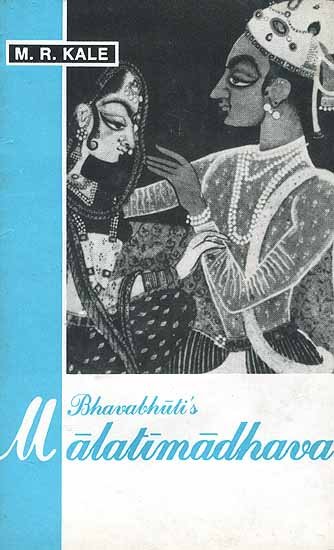Malatimadhava (study)
by Jintu Moni Dutta | 2017 | 52,468 words | ISBN-10: 8120813057 | ISBN-13: 9788120813052
This page relates ‘Malatimadhava as a Prakarana’ from the English study on the Malatimadhava of Bhavabhuti:—A Prakarana type of Drama in ten acts revolving around the love-story of Malati (from Padmāvatī) and Madhava (from Vidarbha). This study discusses the history of its author and the literary, social, religious, historical and cultural aspects of the Malatimadhava.
Part 2a - Mālatīmādhava as a Prakaraṇa
Bhavabhūti’s Mālatīmādhava belongs to the sort of composition termed as Prakaraṇa. Generally, the rhetoricians divide the poetry into two main divisions namely dṛśya which is capable of being seen and śravya which can only be heard[1] . Further, the dṛśya variety is divided into two main broad divisions viz., rūpaka and uparūpaka.[2]
The rūpaka is called so because of the assumption of parts by the actors.[3] It is divided into ten classes viz.,
The uparūpakas are of eighteen types viz.,
- nāṭikā,
- troṭaka,
- goṣṭhī,
- saṭṭaka,
- nāṭyarāsaka,
- prasthānaka,
- ullāpya,
- kāvya,
- preṅkhaṇa,
- rāsaka,
- saṃlāpaka,
- śrīgadita,
- śilpaka,
- vilāsikā,
- durmallikā,
- prakaraṇīkā,
- halliśa and
- bhāṇikā.[5]
Among these the Mālatīmādhava is a Prakaraṇa type of rūpaka. Viśvanātha kavirāja has laid down the characteristics of Prakaraṇa thus—The subject matter of a Prakaraṇa must be drawn from worldly life and imagined by the poet.Here, Śṛṅgāra should be its predominant sentiment and the hero must either be a Brāḥmaṇa, a person of a ministerial rank or a merchant and of the kind of hero called dhīrapraśānta i.e. bold and pacific. The heroine may be a woman of high family, or a courtesan or both[6].
As enumerated the specialities of a Prakaraṇa by the rhetoricians, the theme of the Mālatīmādhava is drawn from worldly life. Although the theme is taken from the Bṛhatkathā the story is not stereotyped one. Some incidents of this Prakaraṇa is entirely a creation of poet’s imagination. The hero of this Prakaraṇa is ministerial rank, son of the minister of the king and he is the kind of hero called dhīapraśānta. On the other hand, the heroine of this Prakaraṇa is a maiden of a high birth (kulajā), daughter of a minister. Hence the heroine of this Prakaraṇa belongs to first variety of Prakaraṇa i.e. high birth (kulajā). Apart from these, here the Śṛṅgāra or Erotic sentiment is delineated as principal sentiment while the other sentiments are delineated as subordinate. Thus, Bhavabhūti followed all the specialities and norms of a Prakaraṇa, which are postulated by the rhetoricians.
Footnotes and references:
[1]:
dṛśyaśravyatvabhedena punaḥ kāvyaṃ dvidhā matam / Sāhityadarpaṇa,VI.1
[4]:
nāṭakamatha prakaraṇaṃ bhāṇavyāyogasamavakāraḍimāḥ /
īhāmṛgāṅkavīthyaḥ prahasanamiti rūpakāṇi daśa // Sāhityadarpaṇa,VI.3
[5]:
nāṭikā troṭakaṃ goṣṭhī saṭṭakaṃ nāṭyarāsakaṃ prasthānollāpyakāvyāni preṅkhaṇaṃ rāsakaṃ tathā //
saṃlāpakaṃ śrīgaditaṃ, śilpakaṃ vilāsikā durmallikā,prakaraṇī halliśo and bhāṇiketi ca// Ibid., VI.4,5
